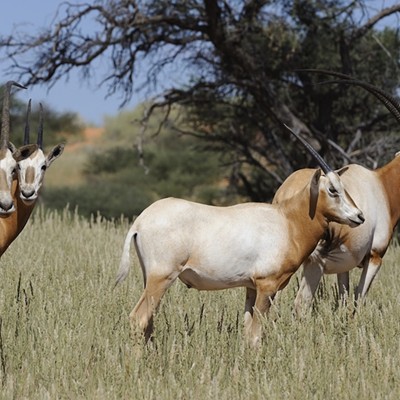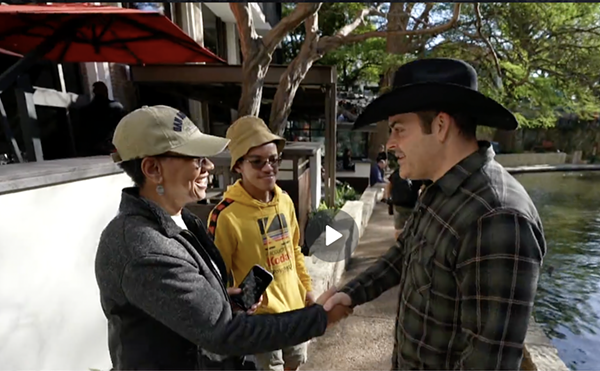See if you can spot the common thread that is pulling at the seams of the Texas film industry.
On NBC’s The Night Shift, a stock-written staff populates the halls of San Antonio Memorial Hospital, dealing with the tendrils of bureaucracy, sexual tension and a non-stop chain of outlandish injuries. Recently picked up for a second season, the SA-set hospital dramedy calls Albuquerque, New Mexico, its home for production.
In the forthcoming MGM action-comedy Don’t Mess With Texas, Reese Witherspoon must protect cartel wife Sofia Vergara during a law-bending romp through the Lone Star State. Set in SA, principal photography began earlier this year in New Orleans and Ponchatoula, Louisiana.
On ABC’s short-lived Killer Women, Texas Ranger Molly Parker (Tricia Helfer) solves a series of murders committed by beautiful women in various cuts of snug-fit clothing. Set in SA, the series’ dreadful two episodes were filmed in Albuquerque prior to a swift cancellation.
Despite major studio interest in San Anto settings, production studios have kept their distance—and, more importantly, their business—from Texas. Like a school day crush gazing from afar, film industry big wigs have kept their eyes on SA without locally filming much more than cameo shots of the Riverwalk, the Alamo and the AT&T Center. In TV and film, New Mexico and Louisiana now substitute for the plains and cities of South Texas.
Like all business decisions, this one comes down to cutting costs. To entice the tax base and massive budgets of Hollywood to spend within their borders, many states (39 plus Puerto Rico) have set up lucrative rebate programs to compete for shoots.
Take New Mexico, where a tax rebate initiative willed into existence a state film industry from thin air. For every dollar spent in-state, filmmakers received 25 percent back as a rebate, with no cap on returns. With major shoots running easily into the multi-millions, LA producers flocked 780 miles east to Albuquerque, eager to cash in on the savings. Under Democratic governor Bill Richardson, from 2003-2011, Harvard’s Institute of Politics reports that there was an economic impact of $3 billion sparked by the motion picture industry.
Upon her inauguration in 2011, New Mexico Governor Susana Martinez stifled the rebate program with a $50 million cap, an action in line with her Tea Party, minimal government roots. But as subsequent in-state film spending began to wane, Martinez changed her mind, even upping the program for television projects from a 25 to 30 percent rebate. Signed into effect in March of 2013, Martinez dubbed the legislation the Breaking Bad Law, named after the acclaimed AMC series that spent $60-$70 million on in-state services and crew wages during its run.
With such a stellar incentive plan, studios have been choosing ABQ soundstages for any locale even remotely similar to the city’s high desert clime. Albuquerque has recently substituted for Wyoming, South Texas and Nebraska, introducing millions into the state economy. And with the incentive and infrastructure firmly in place, New Mexico’s lawmakers and filmmakers intend to keep the money flowing through the Land of Enchantment.
Tall, poised and sitting outside in the incipient morning heat, producer and The Homesman screenwriter Wes Oliver told me of the change in Texas film production caused by the incentive race. “In the early 2000s, there was one medium- to large-budget movie after the other coming to Austin. So many shows coming in that everybody was working all the time. People were working in hotels, restaurants, there’s a lot of ancillary spending that goes on top of that.”
But with the New Mexico rebate in effect as of 2002, Texas industry suffered a creative drought. As film and TV orders dwindled, the infrastructure and crew of San Antonio and Austin were displaced to neighboring states. “About that time, New Mexico and Louisiana incentive programs came in and all that business left,” says Oliver.
San Antonio Film Commissioner Drew Mayer-Oakes recalls the same diaspora in SA film. “There were sound mixers and costumers and hair and makeup people that were here in 2004 when I started as commissioner. And they just left. A lot of them didn’t sell their homes; they still have their families here. And I get an earful every time I visit a set and see San Antonio people. They ask ‘when are you gonna get us some stuff back home? I’m tired of spending eight weeks here, then three weeks at home.’ But it’s the reality.”
To help combat the creative flight, there is an incentive program in place for those making movies in Texas. After a lobbying effort in 2006 by the Texas Motion Picture Alliance, the state set up a program to attract outside business and support local film development. But unlike other states with aid packages, Texas offers a grant, not a rebate. Where a New Mexico rebate draws from the pool of state tax, a Texas grant draws from a finite source determined by the governor’s office.
Though the absence of a state income tax often entices business, in the film industry’s incentive race, the lack of tax is a negative factor. With no state tax to pull from to establish a rebate program, Texas must garner funds from other, smaller sources, leading to a smaller pool.
For the first year of the program, comptroller Susan Combs determined the amount of payroll and sales tax accrued by film production dollars spent in-state, which amounted to $22 million. “We’ve always called that $22 million ‘revenue neutral.’ It’s a wash,” says Mayer-Oakes.
Since that first session, the Texas Motion Picture Alliance and legislators have worked to raise the number, catching the spillover, excess funds from the hotel and motel tax. Over the past biennium, the grant pool for filmmakers was raised to $95 million, according to Mayer-Oakes.
For a city like San Antonio, the return percentages are solid enough to compete. Where New Mexico offers 25 percent returns for film and 30 percent for television, SA is able to offer 25 percent. The state puts in 20 percent for big-budget shoots, plus 2.5 percent for SA’s status as an underutilized area, plus 2.5 percent of sugar on top from the City to sweeten the deal. To qualify for the incentives, 60 percent of total production must occur in Texas and 70 percent of those on the long scroll of credits must be Texan.
But for the industry established in New Mexico, Texas’ kickbacks haven’t been enough to draw filmmakers en masse from their established spots a state over. With TV shows like The Night Shift casually spending over $1 million per episode, the Lone Star coiffeurs can drain fairly quickly without a state tax to refill the money. And over a TV season, a five percent incentive difference can mean millions.
“The creative people always want the authenticity and the business people want the bottom line,” says Oliver. “And the business people win because they ultimately foot the bill. They say ‘who can tell the difference between Albuquerque and San Antonio?’” Consider the local filmmakers, on a small but respectable budget, crafting their vision in celluloid as they see fit. For these small market auteurs, Texas’ grant program has come in various levels of handy.
For SA husband and wife pair Kevin and Robin Nations, a Texas Film Commission grant helped subsidize production on The Adventures of Pepper and Paula, a family feature based on world champion gun-twirler Pistol Packin’ Paula and her dog Pepper.
“The thing I’m most proud of,” says Mayer-Oakes, “with the help of the film commission, we’ve been able to get small grants for local filmmakers to help push them into commercial development. We’re having a hard time attracting out-of-town production, but building the local production that’s financed locally is really positive. It feeds backwards and the national scene sees what’s happening and thinks ‘oh are we missing something, should we be shooting there?’”
But for filmmakers like Scott Langford, who’s been operating on a small budget, the grant program has yet to help his financing. In his hilarious and Apatowian Remake, a group of friends in South Texas try to film a rehash of Braveheart, calling it, simply, Mexican Braveheart. Shot as a short film to entice investment for a feature, Langford’s budget came in well under the Texas Film Commission’s $250,000 minimum tier.
“It was a crazy fast, very ambitious shoot,” says Langford. “I was trying to get the short done, calling in favors from the past 18 years.”
Established with the grant program in 2006, the tier system has been a chafing hole in the wallets of low- and medium-budget filmmakers looking to receive reimbursement. According to the Texas Film Commission’s website, at the $250,000 to $1 million level, projects are eligible for a five percent grant; at the $1 to $3.5 million level, projects are eligible for 10 percent; above $3.5 million, projects are eligible for the full 20 percent.
“That was set up early on to cater to large studio projects and TV series,” says Mayer-Oakes. “The net negative effect is that markets like San Antonio and Houston, where we’re doing a lot of $1 and $2 million features, we don’t get that full rebate or full grant. That’s what’s been frustrating for us in San Antonio. We’re running out of people that can ignore that money savings. In most other states, if you spend $50,000 or $100,000, you get the full rebate.”
For local projects, the tier system functions as an unintentional punishment, denying filmmakers a significant rebate for producing on a small budget. Too high for creatives like Langford, but not competitive enough to attract a consistent flow of big-ticket productions, the tiers appear to frustrate the mission of the Texas Film Commission: “to encourage the development of the film-communication industry … in the social, economic and educational interest of Texas.”
For the next legislative session, Mayer-Oakes hopes that the Texas Motion Picture Alliance can lobby to alter the tiers to make them more practical. Also up for grabs is the amount of grant cash available and the funding from hotel and motel tax overflow. Prospects are looking good to maintain or grow this grant pool. With relatively small investment and large returns, the grant program often flies under the radar of legislative criticism. “The last comptroller’s report said that for every dollar we spent, we generated $18 of business, says “Mayer-Oakes. “They’re good paying jobs with visible benefits for the state.”
The sprawling porches of King William, the vibrant murals of the West Side, the Little Boxes developments hugging the 1604 loop—for filmmakers San Antonio has a diverse style of camera-friendly landscapes waiting to be tapped.
“I think San Antonio is much more photogenic [than Albuquerque],” says Oliver. “I think it’s more photogenic than Austin. I had a project set in Texas and Mexico. I thought we could shoot all of it here. It even had a scene in New Orleans, an old grooming house I thought we could shoot in King William. We scouted and looked for different places and I’m convinced San Antonio could stand in for all those places and not be a cheat.”
“From a practical perspective, it’s nice shooting here because everyone’s very open to help,” says Langford on the hidden benefits of SA sets. “If you go somewhere like LA, NY, New Mexico or Louisiana, they’ve had so much production, it’s almost a nuisance. Here, there’s that glitz and glamor of ‘oh you’re making a movie here’ and people are very open to help.”
Trying to entice The Night Shift to shoot in SA, Mayer-Oakes remembers the show’s creator and line producer (the person who ensures that a project comes in on budget) being stunned by Alamo City opportunity. “The creator knew the city, so he was pushing for it. But the line producer thought it was like El Paso. He thought ‘San Antonio, Albuquerque, doesn’t matter it’s the same thing.’ But when he came in, it really opened his eyes. We were standing on the South Side somewhere, a farming community where the city grew towards it. He said ‘what I love about this town is I could schedule a half-day shoot, three pages looking this way. And instead of moving everybody across Albuquerque to the neighborhood and losing money and time, I just turn the camera around.’ In his brain he just saw money savings.”
“I talk to them regularly, and they’d like to move,” says Mayer-Oakes. “But financially they’re set up in Albuquerque. And I’ve talked to Sony as well, but they’re set up shooting three shows in Albuquerque. So they’re experiencing some costs and savings because they’ve got three production offices all in the same space. But they’re jazzed about the thought of coming to San Antonio, but they’d have to have the financial incentive. Hopefully we’ll be ready with a financial package offer. And the studio would welcome that. They said, ‘no other city has ever talked to us like this before. States have, but cities haven’t.’”
For projects like The Night Shift, integrity suffers when a production is shot away from the intended setting. Filmed in the high Sonoran climate of Albuquerque, those versed in Southwestern geography can call the bluff with ease. Meanwhile, SA awaits the opportunity to showcase the city through a gorgeously shot, well-crafted series like New Mexico’s Breaking Bad or Louisiana’s True Detective, both set and shot on the same ground.
“It’s always going to be a compromise when I know the actual locations exist,” says Oliver.” “I know where the stuff is and I know what it looks like. I know the terrain and I know what the limestone looks like, the trees, cactus and light. I know if you shoot it somewhere else, it’s going to be something different. That to me is the finance and politics standing in the way of something that could glorify the state of Texas.”















